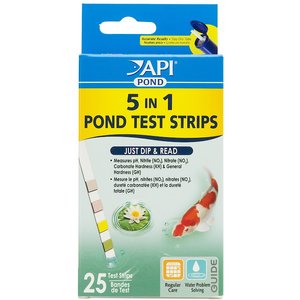How to Raise or Lower PH in Pond Water (Pond PH Guide)
Pond Academy is reader-supported. Buying through links on our site may earn us an affiliate commission. As an Amazon Associate I earn from qualifying purchases.
pH, also known as the potential for hydrogen, is the scale used to determine the basicity or acidity in a liquid.
Typically, your pond will fall into the acceptable pH range and your pond will never see any major spikes or drops in pH…
However, if you notice any changes in your pond’s water clarity, sudden algae blooms, or if your fish have become sick or sluggish, it could signify a pH fluctuation.
So, let's learn what the acceptable pH range is, how to properly test your pond, and how to raise or lower the pH levels to get them back into an acceptable range.
What pH should Pond Water Be?
The pH scale ranges from 0 to 14, with 0 to 6.99 being acidic, 7 being neutral, and 7.01 to 14 being alkaline.
In your typical backyard pond without fish, the ideal pH range is between 6 and 8.5.
So, what is the best ph for a koi pond? If you stock koi, goldfish or other pond fish, the ideal range is a little more restrictive, between 7 and 8.
That’s not to say they won’t survive if the pH level is slightly outside that range, but there is an increased chance that they will become stressed. Too far outside the acceptable range and they will start to suffer from alkalosis or acidosis (depending on which way the pH swings) and may even lead to death.
What Causes Low pH In Ponds?
Typically, if you’re having pH issues in your pond, it’s because of elevated pH levels. However, these levels can drop, as well, meaning that your pond has become more acidic.
So, what causes pH to drop in a pond? Here are a few common culprits:
- Decaying leaves – Fallen leaves that enter your pond can raise the acidity level, thus lowering your pond's pH level. This is more common in Fall when leaves start to fall off the trees and have a higher chance of blowing into your pond.
- Acid rain – It sounds like something out of a horror movie, but acid rain does exist, even if you don’t hear about it much anymore. In fact, all rain is acidic to some extent. And according to the EPA, “The ecological effects of acid rain are most clearly seen in aquatic environments, such as streams, lakes, and marshes where it can be harmful to fish and other wildlife.”
- Carbon dioxide – When carbon dioxide reacts with the water in your pond it creates carbonic acid, which essentially lowers the pH level. Excess carbon dioxide entering your pond can be an issue in heavily stocked ponds and ponds filled with “soft water”, for example.
What Causes High Pond pH Levels?
More commonly, high pH levels in your pond simply mean that the water has become more alkaline.
A high water pH level can be extremely dangerous to koi fish and other aquatic life. Especially when high levels are mixed with warmer temperatures, in which case toxic ammonia is increased.
The causes of high pond pH include:
- Leaking substances – A common culprit of elevated pH levels is the leaking of lime or other chemicals into your pond. Untreated concrete ponds, brick landscaping, and pond ornaments can all leak chemicals into your pond that can affect its pH.
- Algae blooms – Algae uses sunlight and carbon dioxide for photosynthesis. The more algae you have, the more carbon dioxide is used up, which can increase water pH levels and negatively affect water quality.
Get Our Best Pond Tips Sent to Your Inbox for Free!
Join thousands of others and learn from our decades of pond building and maintenance experience! Your pond will thank you!
By subscribing you agree to receive emails from PondAcademy.com. We will always respect your privacy and you can unsubscribe at any time.
How To Test pH Level In Pond Water
While you may suspect that your pond has high or low pH levels, the only way to truly know is to test your pond with a pond water test kit.
You’ll first need to follow the instructions on the specific test kit you have to ensure the results are as accurate as possible.
Then be sure to measure your pond’s pH multiple times throughout the day and average them. For best results, test your pond several days in a row. This is because pH may be lower in the morning and higher in the evening. At night, pond plants and algae will consume oxygen and produce CO2, thus decreasing pH. When the morning arrives, plants will resume photosynthesis and remove carbon dioxide from the water, thus increasing pH.
Also, be sure to measure KH (carbonate hardness) as well and get that in check. Carbonates in your pond water help buffer or moderate pH to prevent those dangerous spikes or drops. Ideally, your KH levels should be between 125 to 200 ppm. If they are low, you can use a KH Booster or sodium bicarbonate (baking soda) to raise it.
If you’re going the baking soda route, then follow the recommended doses on this chart. After adding the recommended amount, wait 6 hours and retest the KH levels.
| Pond Gallons | 30 PPM | 50 PPM | 100 PPM |
|---|---|---|---|
| 100 | .7 oz | 1.2 oz | 2.4 oz |
| 250 | 1.8 oz | 3 oz | 6 oz |
| 500 | 3.6 oz | 6 oz | 12 oz |
| 1,000 | 7.2 oz | 12 oz | 1.5 lbs. |
| 10,000 | 4.5 lbs. | 7.5 lbs. | 15 lbs. |
If you’re unsure how big your pond is, you can use our Pond Calculator to figure out how many gallons your pond holds.
To Summarize
- Use a pond water test kit to get an accurate measure of your pond’s pH level.
- Test multiple times throughout the day and get an average pH reading. Do this over the course of several days.
- Measure the KH level of your pond water, as well, and get that in check. It should read between 125 and 200 PPM. If it’s low, then use a KH Booster or sodium bicarbonate (baking soda) to raise it.
How To Lower Pond pH
Once you’ve followed the testing steps above and are certain your pond's pH levels are out of the acceptable range and the water is too alkaline, it’s time to take the steps necessary to get those levels back into an ideal range.
Here’s how to lower pH in a pond with fish (or without, just know these are all fish safe methods) safely and effectively.
Remove Algae
Before attempting to adjust the pH of your pond, I recommend you first remove one of the causes for daily pH swings, and that is excessive amounts of algae.
We have an extensive guide covering how to get rid of pond algae, that I highly recommend. But, in short, manually removing any string type algae with a pond rake is an effective way to quickly rid your pond of this specific type of algae.
For getting rid of both green and blue-green algae, you can use a UV Pond Clarifier. Run the clarifier for a few days (which should eliminate most of the green algae) and retest the pH levels
Both of these algae removal methods are safe for fish and very effective. And many times, this alone is enough to lower pH in your pond naturally and help eliminate large pH swings between day and night.
Add Vinegar To Pond Water
It may sound like an old wife’s tale, but you can add white or distilled vinegar to lower pH in a pond.
Vinegar should be safe for koi and fish ponds, however, it is a very weak acid and may not work if you have really high pond alkalinity.
For Best Results
- As a rule of thumb, use ¼ cup of vinegar for every 500 gallons of pond water.
- Scoop a bucket of water out of your pond and add the vinegar to the bucket, letting it fully dilute in the water.
- Spread the water/vinegar mix in the bucket throughout your pond.
- Wait 12 hours before retesting your pond’s pH levels.
- Repeat if necessary.
Pondcare pH Down
Pondcare pH Down will help slowly and safely lower the pH level of your pond.
This product is designed to slowly neutralize alkaline substances that raise pH levels.
It’s safe for fish and plants and does not contain any algae promoting phosphates.
And it’s super simple to use! Simply add 1 tsp for every 50 gallons of pond water, wait 24 hours, and test the pH levels again. Repeat as necessary.
What About Muriatic Acid To Lower pH In A Pond?
You can use muriatic acid to lower the pH in a pond, but it’s risky and we don’t recommend it, especially if you have fish as it could cause a massive pH crash and kill your fish.
With that said, many pond owners have effectively used it to lower their ponds pH. Just be warned, start with an extremely small amount and measure the results before adding more.
How To Raise pH In Pond Water
If you’ve accurately measured your pond's pH using the how-to guide above, and the pH levels are indeed lower than the acceptable range, we can raise them with the following methods.
Pond Water Changes
Performing a small water change can help you effectively bring the pH of pond water back to acceptable levels.
And I'm not talking about draining your whole pond and refilling it. Instead, we simply want to replace a small portion of the water with fresh water.
First, you need to drain roughly 25% of your pond with a pond vacuum, your pond’s pump, or a siphon hose. Then, before refilling your pond, test the tap water to make sure its pH levels are in the acceptable range. And use a pond dechlorinator to remove any harmful chlorine and chloramine.
After performing the small water change, test your water again. Repeat if the pH levels are still not in the ideal range.
Baking Soda Method
You can also effectively raise pH levels using sodium bicarbonate, also known as baking soda.
But, how much baking soda should you add to your pond to raise pH levels?
As a rule of thumb, start with 1 tsp for every 10 gallons of pond water. And be sure to fill a bucket with your pond’s water and dissolve the baking soda in the bucket. Then add the bucket of baking soda/pond water mix to your pond spreading it evenly throughout.
After adding the baking soda, wait 24 hours and test again. If your pH levels aren’t budging, you can repeat the process again using 1 tsp for every 5 gallons of water.
Pond pH Buffer
Pond pH Buffer by Water Garden Oasis is designed to raise and control pH in your pond without the use of phosphate.
This product is safe for use in ponds containing plants, koi, goldfish and other pond fish. Plus, it’s not eutrophic and won’t promote algae growth.
To give you an idea of dosing, a 1,000-gallon pond requires 4 ¼ cups of Pond pH Buffer. After dosing, test your pH levels again. Repeat as necessary.











